Thai Spicy Basil Shrimp
The success of this dish depends upon using the freshest shrimp possible. You don’t have to catch them yourself or buy them live, necessarily, but you want very sweet, very fresh shrimp in order for the flavors to balance together perfectly.
You can make this dish with scallops or squid, too–and probably crab, though I have never tried it that way. And of course, if you cannot eat seafood or can’t get any that is good, you can always make this dish with chicken, which is the usual way we eat it at our house anyway, seafood generally being thin on the ground in Southeastern Ohio.
You don’t need to use green beans and carrots as the vegetables in this dish, either. In the spring, I make a version with chicken that has asparagus in it that is absolutely delicious. Or, you can use garlic scapes and shiitake mushrooms. Sweet red or yellow bell peppers would taste really good, too.
If you look at the chicken version of this recipe, you will note that the chicken gets stir fried before the vegetables are added to the wok. The usual order of stir-frying is the aromatics go in at first, then the chicken and when it is nearly cooked through, the vegetables are added.
This version requires that you do the stir-frying in the opposite order–the vegetables get stir-fried after the aromatics and before the shrimp goes into the wok. I do it this way because the shrimp cook so very quickly that if I were to cook it first, they would overcook and become too tough. The freshwater shrimp I had cooked within seconds of hitting the hot wok, so I put them into the wok nearly at the end of the cooking process. The only ingredients that I put in after the shrimp was the basil and the lime juice.
After the lime juice, the dish is finished, and is ready to be scraped from the wok into a serving plate, and is ready to be eaten with plenty of steamed jasmine rice.
One more thing–this dish is meant to be quite spicy hot, so use the fresh Thai bird chilies liberally in it. I have eight Thai chili plants on my deck and they have produced so many fruits that the plants are bent over double. At first, the chilies weren’t very spicy at all, but the recent month’s worth of drought has improved their flavor immensely–now they are fiery and full of a sweet and tangy heat. I got by using only about seven or eight of them instead of the ten or twelve I would have had to use earlier this summer when they were juicier but not nearly so hot.
Oh–and another thing–if you don’t have shrimp stock, you can use chicken broth, fish stock, or vegetable broth instead.
So, without further ado, here is the recipe for Zak’s delicious birthday dinner dish. (Which, hopefully, I can make and eat again someday, preferably without a trip to the emergency room.)
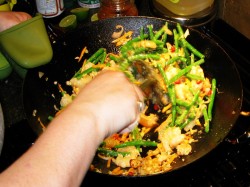
Thai Spicy Basil Shrimp
Ingredients:
2 lbs. fresh shrimp peeled and deveined
1 tbsp. cornstarch
1 tbsp. fish sauce
3 tbsp. peanut oil
4 large shallots, sliced as thinly as you can manage
7-8 Thai bird chiles sliced thinly on the diagonal (or to taste–with me, more is better)
8 cloves garlic minced
2 heaping teaspoons palm sugar or raw sugar
fish sauce to taste–I used about three tablespoons of it for my version–you can use less or more depending on what you like.
3/4 lb. string beans, trimmed, washed, blanched and drained
½ cup carrots cut julienne
1/3 cup shrimp stock
2 cups Thai basil leaves packed
juice of two small limes
Method:
Toss the shrimp, the first measure of fish sauce and the cornstarch together and allow to marinate while you prepare ther est of the ingredients.
Heat the wok on high heat until a thread of thin grey smoke swirls up from the heated surface.
Add the peanut oil to the wok and allow it to heat up until it shimmers in the bottom of the wok–about thirty seconds. Add the shallots and chilies and stir fry until the shallots start to brown and everything is quite fragrant. Add the garlic, palm sugar and fish sauce, then the green beans and carrots.
Stir fry for about a minute, then add the shrimp, scraping all of the cornstarch marinade into the wok.
Stir fry quickly, until shrimp change color–this will take between thirty seconds to a minute.
Add shrimp stock and scrape any browned bits from the wok, then add the basil leaves. Cook, stirring, until the sauce thickens and the basil wilts.
Take the wok off the heat, stir in the lime juice and serve.
5 Comments
RSS feed for comments on this post.
Sorry, the comment form is closed at this time.
Powered by WordPress. Graphics by Zak Kramer.
Design update by Daniel Trout.
Entries and comments feeds.

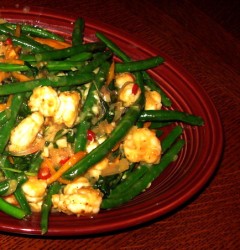
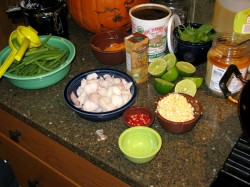
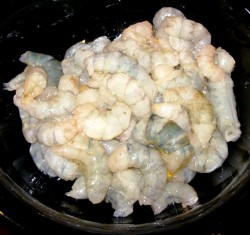
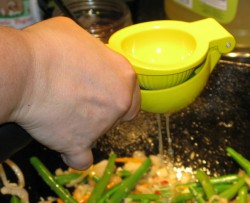

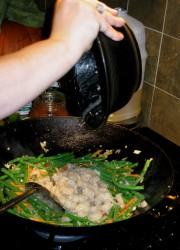


That is a very nice wok! The disk looks/reads tasty!
Comment by Eugenie — September 24, 2008 #
This looks great, I love to make thai food at home!
Comment by Sara — September 24, 2008 #
This looks GREAT! If you don’t have palm sugar, do you use the same amount of other sugar? Would brown or muscovado be better than white, or is the coarseness the important thing?
Comment by Maggie at Pithy and Cleaver — September 25, 2008 #
It is the flavor of the palm sugar that is important. Palm sugar is kind of liquidy-sticky, but its flavor is like flowers. So, when I don’t have any around, I use raw sugar, demerara or brown sugar. But, if I use brown sugar, I use less of it, because the molasses taste is very strong in it.
Comment by Barbara — September 25, 2008 #
Interesting that you have had heat differences in your peppers due to weather. I have pots of poblano, jalapeno, and serrano chilis on my patio and have noticed through the years that fruits maturing in cool weather are usually quite mild while the hot weather summer peppers from the same plants have fire cracker heat–few folks believe this when I tell them.
Comment by janmaus — October 26, 2011 #